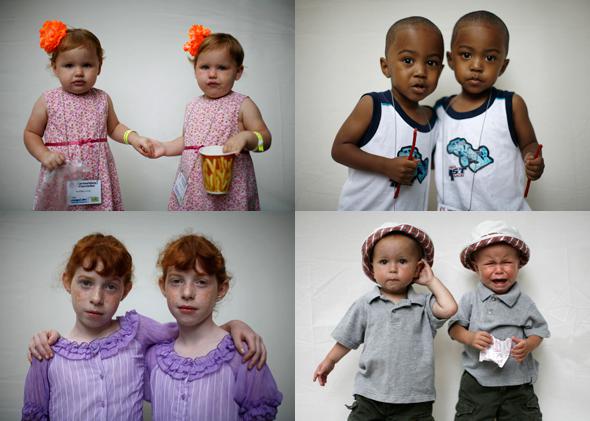Is our behavior determined by genetics, or are we products of our environments? What matters more for the development of living things—internal factors or external ones? Biologists have been hotly debating these questions since shortly after the publication of Darwin’s theory of evolution by natural selection. Charles Darwin’s half-cousin Francis Galton was the first to try to understand this interplay between “nature and nurture” (a phrase he coined) by studying the development of twins.
But are nature and nurture the whole story? It seems not. Even identical twins brought up in similar environments won’t really be identical. They won’t have the same fingerprints. They’ll have different freckles and moles. Even complex traits such as intelligence and mental illness often vary between identical twins.
Of course, some of this variation is due to environmental factors. Even when identical twins are raised together, there are thousands of tiny differences in their developmental environments, from their position in the uterus to preschool teachers to junior prom dates.
But there is more to the story. There is a third factor, crucial to development and behavior, that biologists overlooked until just the past few decades: random noise.
In recent years, noise has become an extremely popular research topic in biology. Scientists have found that practically every process in cells is inherently, inescapably noisy. This is a consequence of basic chemistry. When molecules move around, they do so randomly. This means that cellular processes that require certain molecules to be in the right place at the right time depend on the whims of how molecules bump around.
The result is that two genetically identical cells in the exact same environment will sometimes behave in dramatically different ways. One might go dormant while the other stays active. Or one might produce twice as much of a compound as its sister cell.
Noise sounds like bad news for biology. How can a plant or animal organize its development and behavior when all the processes involved are inherently messy? Indeed, sometimes noise causes real problems. For instance, researchers from the Scott Rifkin lab at the University of California–San Diego have shown that when a certain strain of completely identical, genetically engineered nematode worms are raised in the same environment, some will develop normally while others spontaneously die. In this case, noise means the difference between life and death.
Usually the effects of noise are not so dire. Most organisms have evolved systems to protect themselves from noise. And in fact, biologists have begun to understand that in some cases noise can be a good thing. Cells, organisms, and populations exploit this seemingly detrimental feature of the natural world, sometimes in surprisingly ingenious ways.
To take an example, all the cells in a developing animal start off as identical, undifferentiated stem cells. Some of these will need to become intestinal cells, others liver cells, and others neurons. How does an embryo produce the right proportions of each specialized type of cell in the body? It turns out that noise can help. Consider the different kinds of cells within fruit fly eyes. The facets of a fly’s eye have different colors, and this variation helps fly vision. In each developing fly eye cell, a gene called “spineless” is randomly activated at different levels. This in turn determines the color of the facet. Whether any particular cell develops a particular color is a largely random process, but overall the organism gets the right variety and proportions of different kinds of cells.
Noise can also help defend against the unknown. Bacteria reproduce by cloning, so populations of bacteria are usually highly genetically similar. This can be a problem from an evolutionary standpoint. In cases of environmental change, a uniform population risks being entirely wiped out, since all of the organisms will tend to be susceptible to the same dangers. (This is why we noncloning organisms expend so much time and energy finding sexual partners—because sexual reproduction creates variation.)
In a population with more variety, however, it’s more likely that some individuals will survive an environmental shock. And that’s where noise comes in. For bacteria, random processes can create variation between genetically identical individuals. For example, some cells might enter a dormant phase while others go about their business. This can be thought of as a bet-hedging strategy—random differences between cells will make some less successful but will protect the whole group from extinction. In fact, during periods of environmental change, when a population of cells is most likely to be wiped out, some strains of bacteria actually amplify the noise, creating more variation just when it is needed most.
Unfortunately, this built-in mechanism for creating diversity can cause problems for people. We would prefer to be able to wipe out bacterial populations entirely using antibiotics. Noise may allow small numbers of bacteria to survive, potentially helping spread antibiotic resistance.
Even cancer cells can use noise against us. Variations in protein production in cancer cells protect some of them from chemotherapy drugs, according to a recent study, even though other genetically identical cells are wiped out by the treatment.
Genetic determinism is the view that our genes make us who we are. Popular articles abound describing genes for daredevilishness, creativity, empathy, even being a Republican. Futurists and science-fiction authors predict that genetic engineering will someday allow designer children, built to order, with whatever smarts, looks, and personalities their parents prefer. But biology’s new recognition of the role of noise in development gives us one more reason to think that this simply isn’t going to happen. Gene mapping can’t tell you whether or not your kid will be a skydiver or a conservative, because gene expression is a far more complex phenomenon than biologists long imagined. Even if we can get the genes right, and somehow completely control environments, there will always be noise to make life richly unpredictable.
Update, Sept. 12, 2014: The photo collage at the top of this piece has been updated to only include photos of identical twins.
